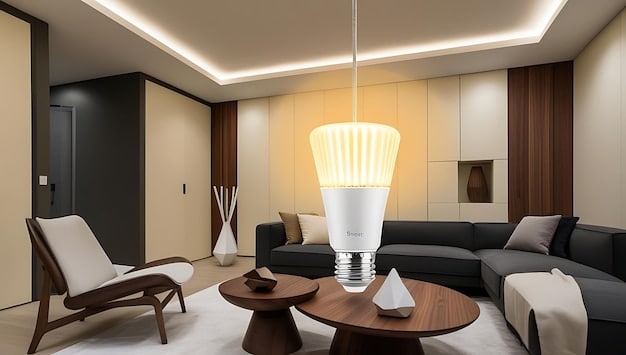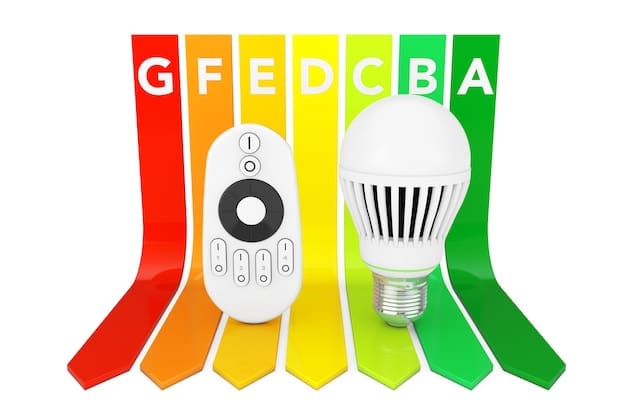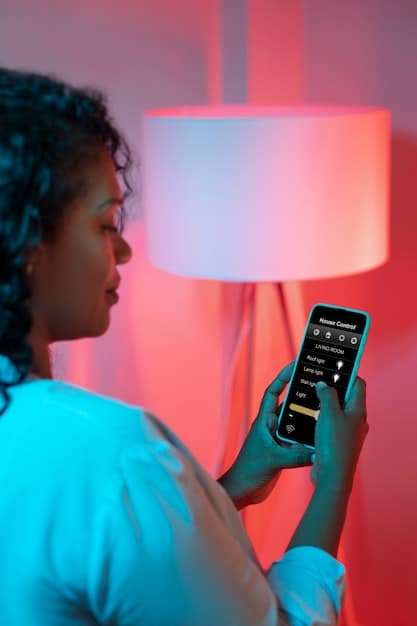Energy-Efficient Lighting: Save Money, Reduce Footprint

Energy-efficient lighting solutions, such as LEDs, significantly cut energy consumption, lower electricity bills, and decrease carbon footprints, making them a smart choice for sustainable living and environmental responsibility.
Switching to energy-efficient lighting is one of the easiest ways to save money and reduce your environmental impact. Let’s explore how you can light your home smarter and greener.
Understanding Energy-Efficient Lighting
Making the switch to energy-efficient lighting is an important step towards a more sustainable lifestyle. It’s not just about replacing old bulbs; it’s about understanding the technology and benefits behind these modern lighting solutions.
What is Energy-Efficient Lighting?
Energy-efficient lighting refers to lighting technologies that provide the same or better light output while using significantly less energy compared to traditional incandescent bulbs.
Key Types of Energy-Efficient Lighting
The most common types of energy-efficient lighting include:
- LEDs (Light Emitting Diodes): Known for their long lifespan and low energy consumption, LEDs are the most popular choice.
- CFLs (Compact Fluorescent Lamps): While less common now, CFLs are still more efficient than incandescent bulbs and can be a cost-effective option.
By understanding these options, you can make informed decisions about which lighting solutions best fit your needs and help reduce your carbon footprint.
In summary, energy-efficient lighting is a game-changer for both your wallet and the environment, offering substantial savings and reducing energy consumption.
Benefits of Energy-Efficient Lighting
Choosing energy-efficient lighting offers several key advantages that extend beyond just simple cost savings. From environmental benefits to improved lighting quality, the benefits are numerous.
Lower Electricity Bills
One of the most immediate and noticeable benefits is the reduction in your electricity bill. Energy-efficient bulbs use significantly less energy, translating directly into savings each month.
Reduced Carbon Footprint
By using less energy, you’re also reducing the demand on power plants, which often rely on fossil fuels. This leads to a smaller carbon footprint and helps combat climate change.
- Decreased greenhouse gas emissions
- Less strain on natural resources
- Support for a greener environment

Understanding and embracing energy-efficient lighting is key to creating a brighter, more sustainable future for everyone. It’s an investment in both your financial well-being and the health of the planet.
Choosing the Right Energy-Efficient Bulbs
Selecting the right energy-efficient lighting involves more than just grabbing any LED bulb off the shelf. Here’s what to consider to ensure you get the best fit for your needs.
Understand Lumens, Not Watts
Lumens measure brightness, while watts measure energy use. Focus on lumens to get the brightness you need while minimizing energy consumption.
Check the Color Temperature
Color temperature is measured in Kelvin (K). Warmer temperatures (2700K-3000K) provide a cozy, yellowish light, while cooler temperatures (4000K-5000K) offer a brighter, more energizing light.
- Consider warm light for bedrooms and living rooms
- Use cool light for kitchens and workspaces
- Match the color temperature to your existing decor
Selecting the right bulb involves considering brightness, color temperature, and special features. By considering these aspects, you will be able to meet all your needs.
Implementing Energy-Efficient Lighting at Home
Integrating energy-efficient lighting into your home is a straightforward process that can yield significant benefits. A room-by-room approach can help ensure you maximize efficiency and savings.
Living Room
In the living room, consider using dimmable LED bulbs to adjust the lighting to suit different activities, such as reading, watching TV, or entertaining guests.
Kitchen
The kitchen benefits from bright, cool lighting to aid in food preparation and cooking. LED spotlights can be used to highlight countertops and work areas.
Implementing energy-efficient lighting throughout your home not only lowers your energy bills but also enhances the comfort and functionality of your living spaces.
Smart Lighting Systems
Adopting energy-efficient lighting becomes even more powerful when combined with smart home technology. Smart lighting systems offer enhanced control and automation features.
What are Smart Lighting Systems?
Smart lighting systems allow you to control your lights remotely using a smartphone, tablet, or voice commands. These systems often include features like dimming, scheduling, and motion sensing.
Benefits of Smart Lighting
Here are some key advantages of using smart lighting:
- Remote Control: Adjust your lights from anywhere using your smartphone.
- Scheduling: Set lights to turn on and off at specific times or based on sunrise and sunset.
- Motion Sensing: Lights turn on automatically when motion is detected, saving energy when rooms are unoccupied.

By investing in smart lighting systems, you can further optimize your energy consumption and create a more convenient and efficient home environment. Smart lighting systems are one of the futures of the planet.
Overcoming Common Misconceptions
Some common misconceptions about energy-efficient lighting can prevent people from making the switch. Let’s address some of these to clarify the real benefits.
Myth: Energy-Efficient Bulbs are Too Expensive
Fact: While the initial cost may be higher, energy-efficient bulbs last much longer and use significantly less energy, resulting in long-term savings.
Myth: The Light Quality is Poor
Fact: Modern energy-efficient bulbs, especially LEDs, offer a wide range of color temperatures and brightness levels to suit any preference.
By understanding the facts and dispelling these myths, you can confidently embrace energy-efficient lighting and enjoy its many benefits. Energy-efficient lighting is one of the greatest inventions in history.
Conclusion
Making the switch to energy-efficient lighting is a beneficial measure that not only saves you money but also makes a contribution to a more sustainable planet. By understanding the types of energy-efficient lighting, their benefits, and how to implement them effectively, you can make informed choices that benefit both your wallet and the environment.
| Key Point | Brief Description |
|---|---|
| 💡 LED Benefits | Long lifespan and low energy consumption. |
| 💰 Cost Savings | Lower electricity bills and reduced carbon footprint. |
| 🏡 Smart Lighting | Remote control and automated scheduling. |
| 🌍 Environmental Impact | Reduced greenhouse gas emissions. |
Frequently Asked Questions (FAQ)
▼
Lumens measure the brightness of a bulb, while watts measure the amount of energy it uses. When choosing a bulb, focus on lumens to get the desired brightness while using fewer watts to save energy.
▼
Yes, LED bulbs are worth the higher upfront cost. They last much longer than traditional bulbs and use significantly less energy, resulting in substantial savings on your electricity bill over time.
▼
Choose warmer color temperatures (2700K-3000K) for cozy areas like bedrooms and living rooms. Cooler temperatures (4000K-5000K) are better for kitchens and workspaces where bright, energizing light is needed.
▼
Smart lighting systems are compatible with most standard light fixtures. However, make sure to check the compatibility of the smart bulb or switch with your existing fixtures, especially if you have dimmer switches.
▼
Energy-efficient lighting reduces the demand on power plants, many of which rely on fossil fuels. By using less energy, you decrease greenhouse gas emissions and contribute to a smaller carbon footprint, helping combat climate change.
Conclusion
Embracing energy-efficient lighting represents a practical and effective approach to decreasing your environmental footprint and conserving energy. By understanding the available options and their associated benefits, you can make informed choices that lead to a more sustainable lifestyle.





